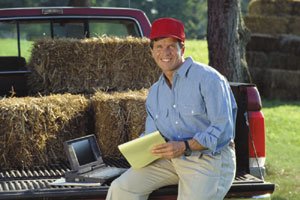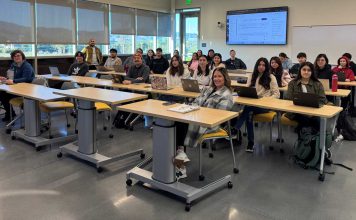From barn cams to tractors that can steer themselves, more and
more farmers are turning to technology to increase their
productivity and control costs.
Rick Barrett – Milwaukee Journal Sentinel
From barn cams to tractors that can steer themselves, more and more farmers are turning to technology to increase their productivity and control costs.
“It’s all about precision agriculture,” said Kevin Jarek, a University of Wisconsin Extension agent. “Farmers literally need to figure their expenses to a fraction of a penny.”
Consider the way David Nelson of Stoughton, Wis., uses high-tech tools on his 1,200-acre grain farm:
Computerized equipment in his combine provides a constant readout of his crop yield as he harvests his fields.
A subscription to DTN, an electronic information service, provides him with up-to-the-minute weather tracking, down to a precise spot in any field.
The same service monitors commodities trading in Chicago and can send his cell phone a text message when prices hit a designated target.
Earlier this year, Nelson used the service to lock in the price of 9,000 gallons of diesel fuel at $2.96 a gallon. The move saved him nearly $10,000 as diesel prices soared shortly afterward.
“DTN puts up a pretty good report on what’s going on,” Nelson said.
Such technology is becoming commonplace, particularly on larger farms, as agriculture works to keep up with growing demand while keeping costs from getting out of hand. More than half of U.S. farmers now use at least one high-tech tool, according to an Ohio University study.
“It’s apparent how successful technology is in farming today, as we are producing more every year with fewer farmers,” said Tamara Kass, director of agricultural products for Omaha, Neb.-based DTN.
For example, in 1997 the national average corn yield per acre was 128 bushels. Seven years later it was up to 160 bushels. And milk production has increased 18 percent per cow over the last 10 years.
“Not only do farmers have to adopt new technology to stay profitable,” Kass said, “they also must embrace it in order to feed a growing global population.”
The technology typically doesn’t come cheap. A DTN subscription costs about $1,000 a year, and other gadgets often run into the thousands of dollars. But they sometimes can pay for themselves quickly – through less chemical usage and reduced labor, for example.
Nelson leaves his DTN terminal turned on all day so he can monitor the wind’s speed and direction, which are important to know when applying herbicides and chemicals with a sprayer. He also uses the service to keep tabs on things such as ethanol markets, which have a direct impact on grain prices.
Farmers wanting to stay current on other matters download podcasts to their computer from Badgerland Financial, based in Mount Horeb, Wis., and the Dairy Business Association.
The podcasts, which are recorded broadcasts delivered over the Internet to a computer or iPod, cover subjects such as farm worker immigration law. They’re popular with farmers seeking information they can listen to at their convenience, said Steve Schwoerer, a dairy specialist with Badgerland Financial, a farm lender.
“The size of the farm isn’t dictating technology anymore. Pretty much all farms have something,” Schwoerer said.
Even so, having a farm loaded with GPS and the latest information services doesn’t necessarily result in better business decisions. It can be like having a treadmill in your basement but never using it.
Farmers also need time to process the reams of data and reports available at their fingertips.
“That’s the trump card,” Jarek said. “If a rainstorm is moving in and you have a field of hay to cut, you can’t always take time to find the nearest computer terminal to check grain prices. We can all have our computers and figure things out in parts per million, but farming is still hard, physical work with no guarantees. And just because someone has information, it doesn’t mean they will reach the right conclusions.”
Some technologies have been slower to come to the farm, in part because electronics couldn’t handle the outdoors or barn dust.
But the equipment has become more rugged, allowing it to be used in harsh conditions and encouraging farmers to become part of the digital world.
“The average age of our farmers is getting up there, yet we are seeing more of them using things like GPS,” Jarek said.
“Our society is all about getting things done better, quicker, faster,” he added. “And the way you do that in agriculture is with information.”
Global-positioning satellites can help steer tractors and harvesting machines, although an operator usually remains in the vehicle’s cab for safety reasons. The technology, which is not yet widespread, can plot out a field to the inch and steer a tractor much like a car’s cruise control manages its speed.
“You still need an operator in the tractor cab,” said University of Wisconsin Extension agent Jarek, “but now you get corn rows as straight as a picket fence.”















